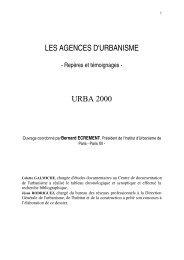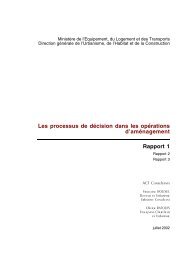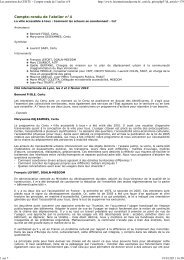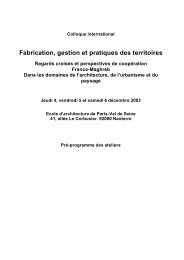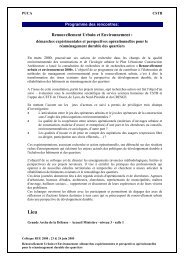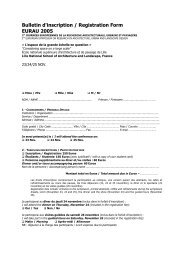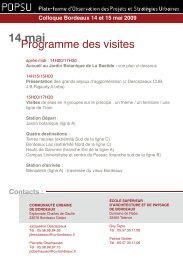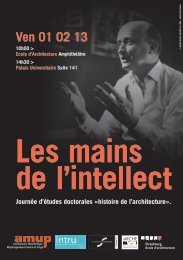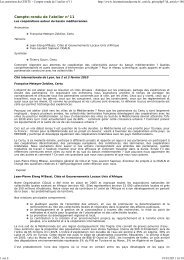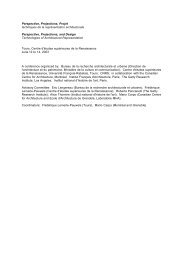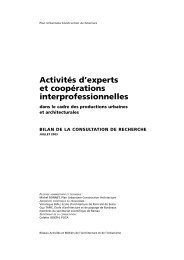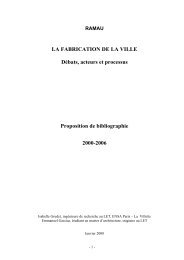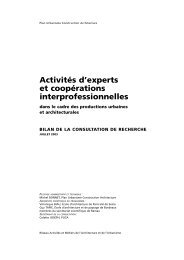Cahiers Ramau 2 en totalité
Cahiers Ramau 2 en totalité
Cahiers Ramau 2 en totalité
Create successful ePaper yourself
Turn your PDF publications into a flip-book with our unique Google optimized e-Paper software.
261<br />
the mission unbalances), an instrum<strong>en</strong>tation meaning (what the mission helps to foreshadow)<br />
and a professionalisation meaning (what the mission may lead on to).<br />
Christian Thuderoz, CNRS, INSA Lyon. Some remarks about the notion of confid<strong>en</strong>ce The<br />
author first states that the confid<strong>en</strong>ce issue has not be<strong>en</strong> treated before now by social analysts.<br />
Th<strong>en</strong>, he examines various approaches to the social world which have structured sociological<br />
reasoning: the integration/differ<strong>en</strong>tiation pair, the issue of rationalisation, and the issue of<br />
interactions. He proposes statem<strong>en</strong>ts which define confid<strong>en</strong>ce, illustrating their application<br />
with examples, and th<strong>en</strong> various levels of conceptualisation or construction of the confid<strong>en</strong>ce<br />
concept. He relates the conflict, interest, co-operation and g<strong>en</strong>erosity concepts with the differ<strong>en</strong>t<br />
regimes of confid<strong>en</strong>ce. These are interested confid<strong>en</strong>ce, reciprocity, b<strong>en</strong>evol<strong>en</strong>ce and<br />
restrained confid<strong>en</strong>ce. Finally, he briefly applies this analysis to design activities within the<br />
framework of a complex actor system.<br />
Thérèse Evette, D<strong>en</strong>is Plais, LET-EAPLV, LET-EAL. Uncertainty and arrangem<strong>en</strong>ts to<br />
promote confid<strong>en</strong>ce in corporate architecture Starting from the simple statem<strong>en</strong>t that, in<br />
the case of a property project, particularly within the corporate architecture area, cli<strong>en</strong>ts have<br />
to assemble professionals with abilities which they cannot completely master (i.e. finance advisers,<br />
architects or <strong>en</strong>gineers who interv<strong>en</strong>e by providing their services), and that therefore the<br />
actors involved in such a project, i.e. cli<strong>en</strong>ts and service providers, are establishing relationships<br />
which bear the stamp of a degree of uncertainty (this is actually common in various other<br />
service markets), the authors have examined relationships established betwe<strong>en</strong> industrial<br />
and tertiary sector companies and their providers during workplace design. Within the framework<br />
of an «economy of quality » approach, within which confid<strong>en</strong>ce ph<strong>en</strong>om<strong>en</strong>a play a crucial<br />
role, they drew on research dealing with the commissioning of architecture projects. Referring<br />
to an industrial project (a production unit of Boiron laboratories in Messimy, Rhône) and to a<br />
tertiary project (Air France headquarters in Roissy, Seine-Saint-D<strong>en</strong>is), they examine uncertainties<br />
pres<strong>en</strong>t in this kind of project, those inher<strong>en</strong>t in the project itself as well as those<br />
dep<strong>en</strong>d<strong>en</strong>t on the company’s activity. Th<strong>en</strong>, they discuss strategies which are implem<strong>en</strong>ted to<br />
control the risks g<strong>en</strong>erated by these uncertainties, and finally the confid<strong>en</strong>ce arrangem<strong>en</strong>ts set<br />
up in the design process and their articulation with control arrangem<strong>en</strong>ts.<br />
Olivier Chadouin, ARD, EAPBx. Confid<strong>en</strong>ce as a consequ<strong>en</strong>ce. Conditions of architectural<br />
and urban co-ordination Based on a case study of the production of the Paris-Bercy ZAC (Zone<br />
d’aménagem<strong>en</strong>t concerté), this article focuses on the creation of a “co-ordination architect”<br />
by the Atelier Parisi<strong>en</strong> d’Urbanisme (APUR) as an illustration of the way a compromise is built<br />
up and based on an organisational innovation. After having recalled the project context, the<br />
author briefly describes its various elem<strong>en</strong>ts, emphasising the housing elem<strong>en</strong>t. The project<br />
relies on three actors: a “maîtrise d’ouvrage déléguée” (delegated cli<strong>en</strong>t), mainly public<br />
“maîtres d’ouvrage” (cli<strong>en</strong>ts), and a co-ordination architect, this last mission being indeed an<br />
originality. Besides questions about the operation of this organisation, the author seeks to id<strong>en</strong>tify<br />
conditions for success and also for its acceptability by the various project actors. More<br />
precisely in the case of the above m<strong>en</strong>tioned housing part of the project, the author tries to<br />
see how some harmonisation of the buildings could be obtained while keeping an heterog<strong>en</strong>eous<br />
arrangem<strong>en</strong>t in action, and how it was made possible to tune the voices of the famous actors<br />
who were pres<strong>en</strong>t – the co-ordination architect is sometimes named “arbiter of taste” or said<br />
to have a “warrant for courtesy rules”; he also tries to specify the terms, that is under which



